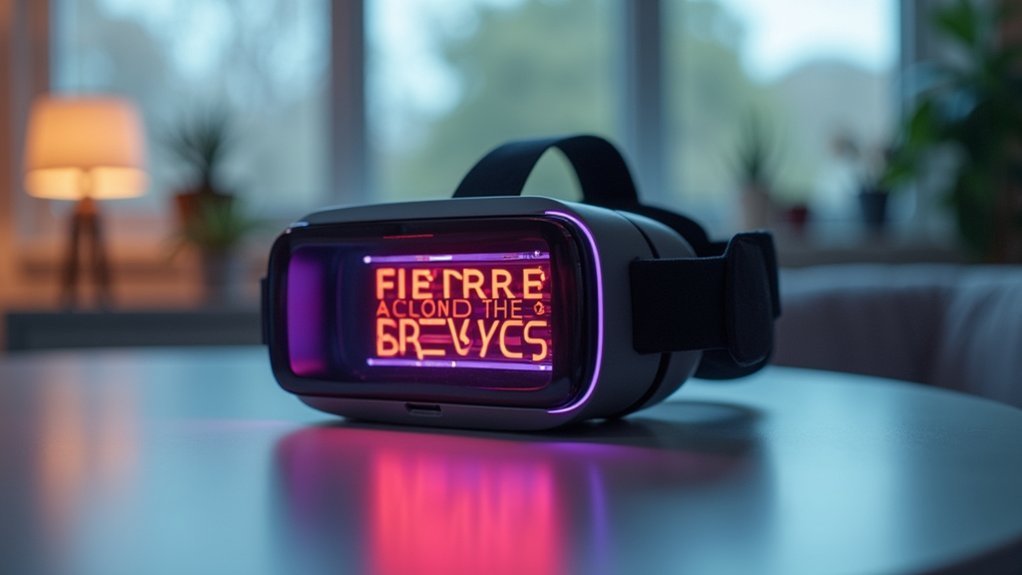You’ll struggle to read standard-sized text in virtual reality environments because VR headsets magnify visual strain while reducing clarity, making larger fonts essential for comfortable interaction and accessibility compliance. Larger text reduces cognitive load, prevents eye fatigue, and guarantees users with visual impairments can navigate VR spaces effectively. WCAG guidelines recommend 200% text scaling capabilities, with minimum font sizes of 18-24 pixels for ideal VR legibility. Continue exploring to discover extensive implementation strategies.
Understanding Visual Accessibility Challenges in Virtual Reality Environments

When you enter a virtual reality environment, you’re immediately confronted with visual challenges that don’t exist in traditional digital interfaces. The immersive settings create unique obstacles for users with visual impairments, who represent one in four adults.
Unlike standard web accessibility practices, VR amplifies difficulties through motion blur and three-dimensional navigation complexities.
You’ll find that traditional text sizes become inadequate in virtual spaces, where depth perception and head movement affect readability. The need for larger font size becomes critical when you consider how VR headsets can strain eyes differently than monitors.
Text scalability must adapt to WCAG standards while maintaining functionality within the virtual environment. Without proper consideration for these challenges, you risk excluding millions of users who depend on accessible design principles.
How Text Size Impacts User Engagement and Comprehension in VR
Because text size directly affects how your brain processes visual information in virtual reality, larger fonts create measurably better engagement rates and comprehension levels. When you’re maneuvering through immersive VR environments, your cognitive load decreases considerably with appropriately sized text, allowing faster information absorption and better retention.
User engagement improves dramatically when you can read content without eye strain. Larger fonts also establish clear visual hierarchies that guide your movement through complex virtual spaces.
| Text Size Benefit | Impact on User Experience |
|---|---|
| Reduced Eye Strain | Extended VR session duration |
| Faster Reading Speed | Improved information processing |
| Better Focus | Enhanced content absorption |
| Clear Navigation | Smoother user journey |
| Inclusive Design | Universal accessibility compliance |
For accessibility in immersive VR, larger fonts guarantee you’ll maintain ideal user comprehension regardless of your distance from virtual displays.
Cognitive Load Reduction Through Optimized Text Scaling

When you encounter appropriately scaled text in VR environments, your brain processes information more efficiently without working overtime to decode small or unclear fonts.
You’ll find that larger text directly enhances your reading comprehension by allowing you to focus on content meaning rather than struggling to recognize individual characters.
This optimized scaling minimizes the visual strain that forces your cognitive resources away from understanding information and toward basic text recognition tasks.
Mental Processing Efficiency
Although your brain constantly processes visual information, larger text greatly reduces the mental effort required to decode written content. When you encounter properly sized fonts, your cognitive load decreases markedly, allowing faster information absorption without eye strain.
Larger font sizes create accessible experiences for users with visual impairments while improving readability for everyone.
You’ll process information more efficiently when text meets the recommended 16px minimum, as your brain doesn’t waste energy struggling to interpret small characters. This optimization enables quicker reading speeds and better comprehension, particularly benefiting older adults and individuals with learning disabilities.
Reading Comprehension Enhancement
As your eyes encounter optimized text scaling, your brain dedicates more processing power to understanding meaning rather than struggling to decode individual characters.
When you’re working with accessible font sizes of 16 pixels or larger, you’ll notice dramatically improved reading comprehension as cognitive load decreases.
This enhancement particularly benefits users with visual impairments, who can process information faster when text doesn’t strain their visual system.
Consider these key improvements:
- Character Recognition: Larger font size eliminates the mental effort needed to distinguish between similar letters
- Word Processing: Your brain can quickly identify complete words rather than assembling individual characters
- Context Understanding: Reduced decoding effort allows deeper focus on meaning and retention
Optimized text scaling transforms reading from a challenging task into an effortless, engaging experience.
Visual Strain Minimization
Since your visual system expends tremendous energy deciphering small text, larger font sizes directly combat eye fatigue by reducing the muscular tension required for focus.
When you increase font size to at least 16 pixels, you’re eliminating the squinting and straining that forces your eyes to work overtime. This visual strain reduction makes content accessible to people with varying visual capabilities while decreasing cognitive load considerably.
WCAG guidelines mandate 200% text scaling precisely because smaller fonts create unnecessary barriers.
You’ll find that easy to read text doesn’t just prevent headaches—it allows your brain to process information more efficiently. Instead of dedicating mental resources to decoding tiny characters, you can focus entirely on comprehension and retention, creating a smoother, more comfortable reading experience.
Technical Implementation of Dynamic Text Resizing in VR Applications

You’ll need adaptive scaling algorithms that automatically adjust text size based on user distance and viewport changes in real-time.
These algorithms must calculate ideal font scaling ratios using depth perception data and user movement tracking to maintain readability without compromising performance.
Your implementation should prioritize real-time performance optimization through efficient rendering techniques that prevent frame rate drops during dynamic text adjustments.
Adaptive Scaling Algorithms
When you’re developing VR applications with accessible text, adaptive scaling algorithms become the backbone of dynamic resizing systems that respond intelligently to user needs.
These sophisticated systems leverage machine learning to predict and automatically adjust text size based on your distance from virtual elements and individual visual capabilities, greatly improving accessibility for users with low vision.
The algorithms enhance user experience through three key mechanisms:
- Real-time data collection – Monitoring user interactions and preferences to inform scaling decisions
- Automatic contrast ratio optimization – Adjusting text visibility alongside size modifications
- Cognitive load reduction – Minimizing eye strain through seamless font adjustments
However, you’ll need to balance these benefits against performance considerations, as real-time adaptive scaling algorithms can impact application responsiveness if not optimized properly.
Real-Time Performance Optimization
Implementing these adaptive scaling systems requires careful attention to performance bottlenecks that can disrupt the immersive VR experience.
You’ll need GPU acceleration to maintain smooth text rendering during dynamic text resizing operations without compromising frame rates. Real-time performance optimization becomes critical when users activate accessibility controls that adjust font sizes on demand.
Your adaptive font scaling algorithms must process quickly to preserve readability while users interact with content.
Integrating responsive user controls allows immediate text adjustments, but you’ll need efficient rendering pipelines to handle these changes seamlessly. Performance monitoring tools help you identify latency issues that could break immersion.
User Control and Customization Options for Text Display
Why should accessibility depend solely on developers’ design choices when users themselves can take control of their reading experience?
User control transforms how people interact with text, offering customization options that adapt to individual accessibility needs. When you implement responsive design with relative units like rems or ems, you’re enabling seamless font size adjustments across devices while maintaining functionality.
User-driven customization breaks the one-size-fits-all approach, letting individuals tailor text display to their specific accessibility needs and preferences.
Essential customization features include:
- Adjustable font sizes that scale up to 200% while preserving layout integrity
- Variable line spacing controls that reduce cognitive load and enhance comprehension
- Contrast adjustment settings that accommodate visual impairments and personal preferences
These readability enhancements empower users to create personalized viewing experiences.
Rather than forcing everyone into identical designs, you’re providing tools that let individuals optimize text display according to their unique requirements and comfort levels.
Best Practices for Inclusive VR Text Design Standards
As virtual reality environments present unique challenges for text readability, you’ll need to establish robust design standards that guarantee accessibility across diverse user needs.
Start with a minimum font size of 18-24 pixels, which exceeds traditional web design recommendations but proves essential for VR legibility. Choose sans-serif fonts exclusively, as they maintain clarity across varying distances and viewing angles within immersive spaces.
Implement WCAG-compliant contrast ratios of at least 4.5:1 between text and backgrounds to support users with low vision. Create clear typographic hierarchies using larger text for headings and subheadings, enabling quick information scanning.
Run your designs through an accessibility checker to verify compliance. Most importantly, build scalable text systems that allow users to customize font sizes according to their individual preferences and visual requirements.
Frequently Asked Questions
What Is the Best Font Size for Accessibility?
You’ll want to use at least 16 pixels for body text, though 19 pixels works better for older adults. Use relative units like rems and make certain your text’s resizable to 200% for peak accessibility.
What Is Considered Large Text in Accessibility?
You’ll find large text defined as 18 points or larger for regular text, or 14 points when bolded. This standard helps you meet WCAG’s 3:1 contrast requirements while improving readability for users.
What Is the Recommended Font Size for ADA?
The ADA doesn’t specify exact font sizes, but you’ll want to follow WCAG guidelines recommending 16 pixels minimum for body text and 19 pixels for older adults to guarantee proper accessibility.
Why Is Text Size Important?
Text size affects your ability to read comfortably and comprehend information effectively. You’ll experience less eye strain with larger text, and it guarantees you can access content regardless of visual impairments or aging-related vision changes.





Leave a Reply